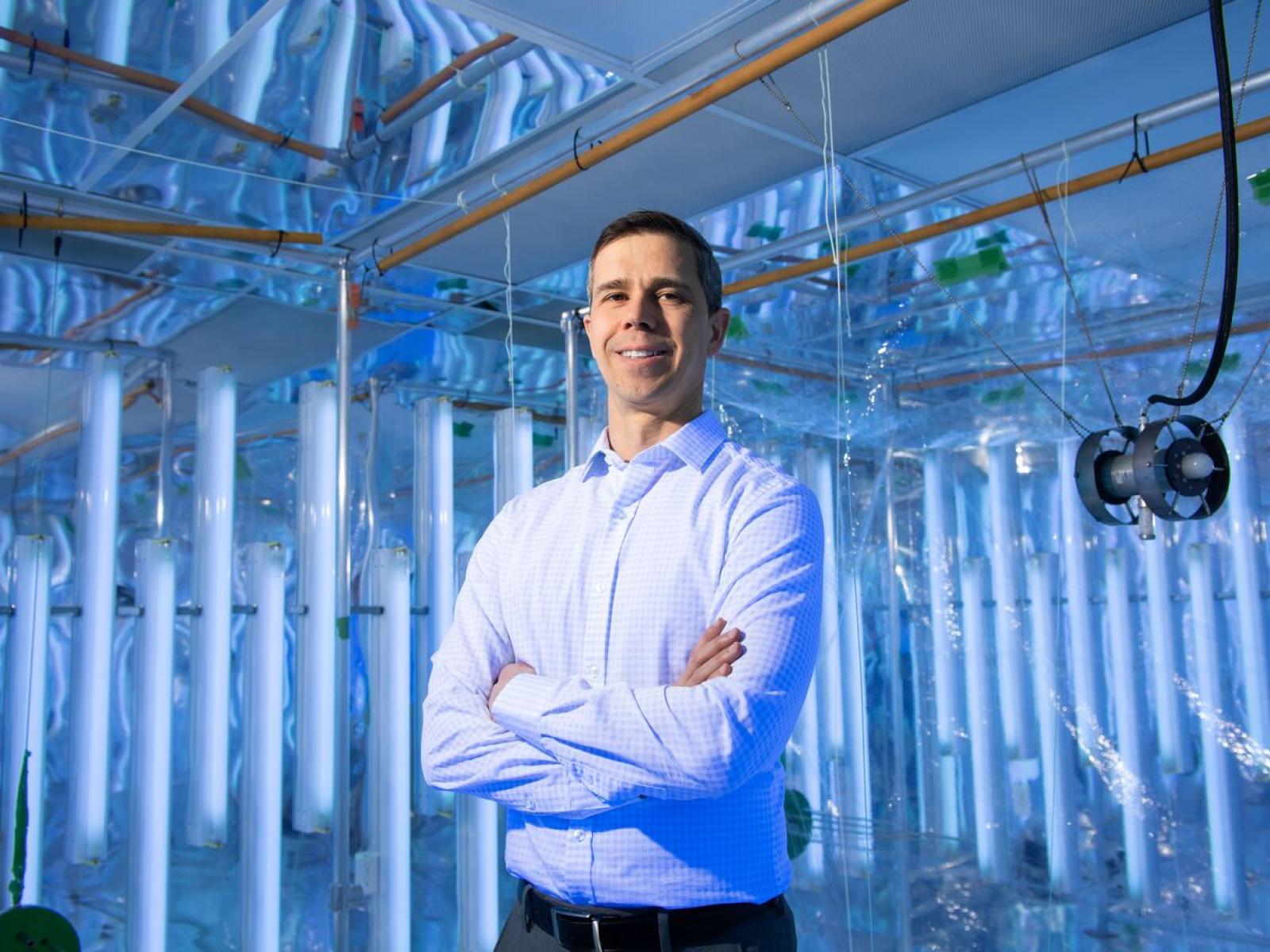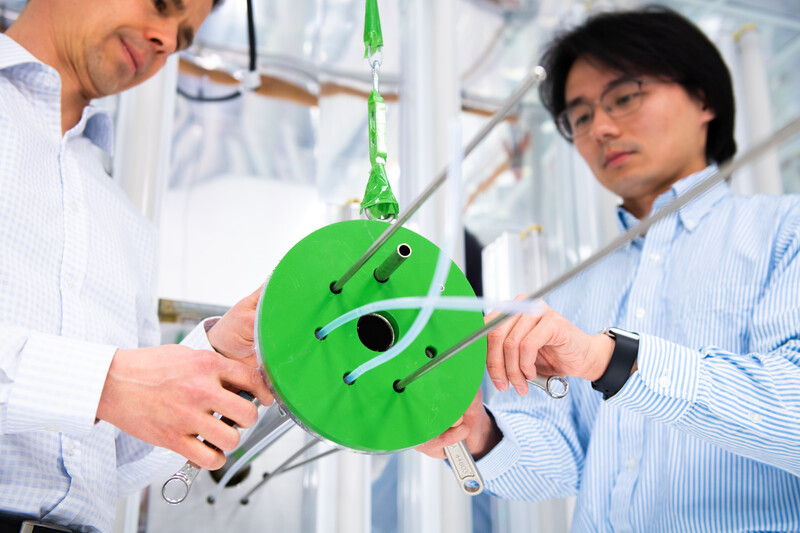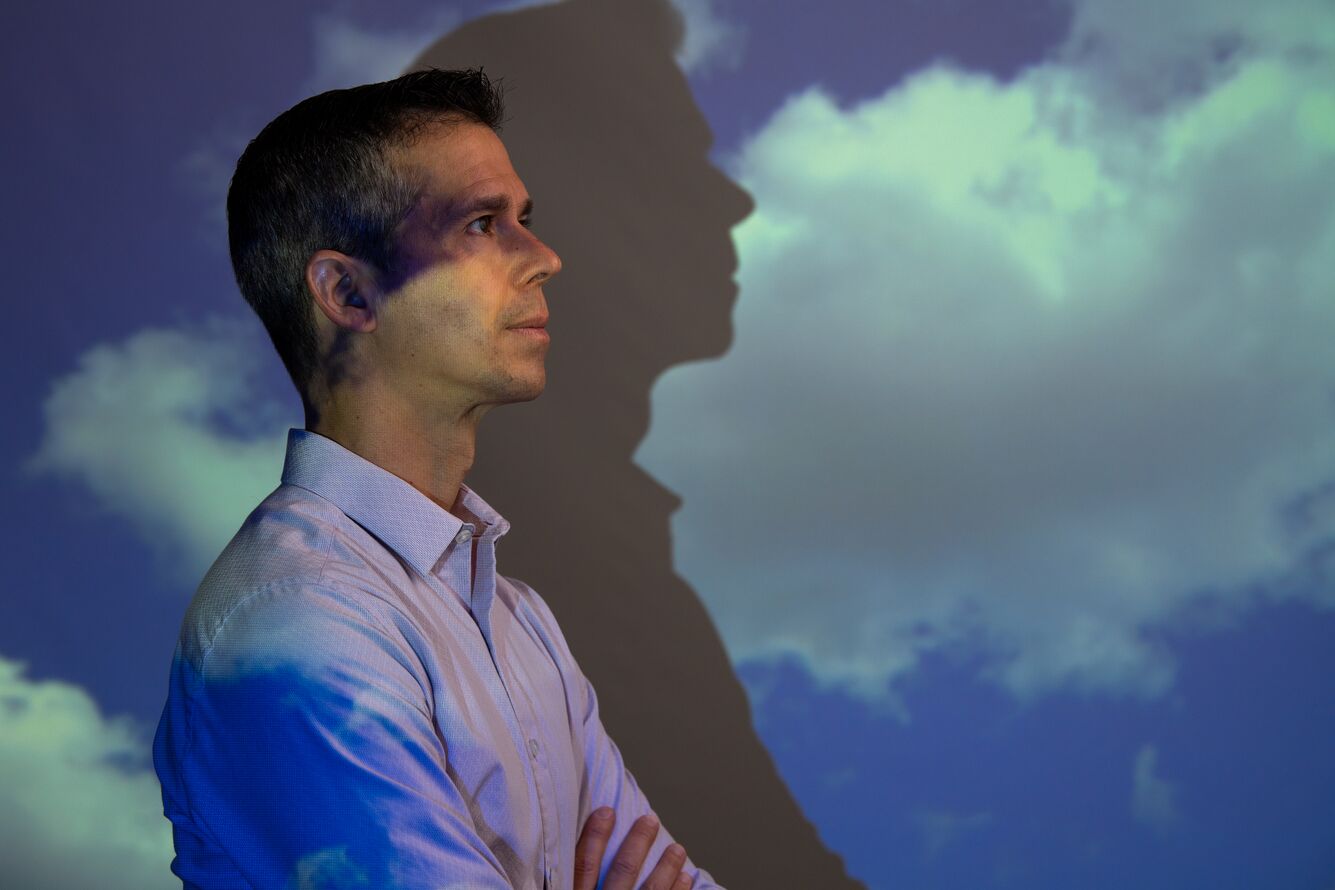This story is based on an article by Jesenia Hernandez that was published on the Pacific Northwest National Laboratory website on October 17, 2024.
ASR scientist builds custom chamber to help uncover how aerosol particles and clouds contribute to a changing climate

Pacific Northwest National Laboratory (PNNL) chemist John Shilling wears soundproof earmuffs as he sits between freezer-chest-sized scientific instruments in an airplane. The instruments—measuring gas and aerosol particles as the plane navigates the sky—will later return to a laboratory custom built by Shilling, where he works to create clarity around one of climate science’s most baffling sources of complexity: the influence of aerosols on clouds.
“All clouds start as an aerosol particle,” said Shilling. “Aerosols are any kind of solid or liquid that are suspended in the air, from smoke to dust, or even bits of tires that come off the road. They are also formed in the atmosphere from gases given off by trees or emitted by tailpipes.”
Many questions surrounding the processes that drive aerosol particles to grow and influence clouds remain unanswered, leading to uncertainties in future climate projections. But big discoveries are unfolding behind the Environmental Chamber Laboratory door on the PNNL campus in Richland, WA, where a room about the size of an elevator car simulates the Earth’s atmosphere.
Today, the chamber hosts experiments and researchers from around the world and has supported more than 40 research publications. But building it required a compelling vision, patience, and a massive effort from Shilling and his colleagues.
Shilling has been an ASR-funded scientist since 2010. He currently is an active member of the Integrated Cloud, Land-surface, and Aerosol System Study (ICLASS) Science Focus Area and the following ASR research projects: Elucidating the Impacts of Shallow and Deep Convective Cloud Processing on Biogenic VOC-Driven Particle Formation and Growth, and A Community Laboratory Facility for Exploring and Sensing of Aerosol-Cloud-Drizzle Processes: The Aerosol-Cloud-Drizzle Convection Chamber.
The Vision: Transform a Locker Room into a Laboratory
Shilling started his research career as a graduate student interested in the properties of ice. He was especially fascinated that ice particles in the atmosphere, along with other particles like salt spray, could absorb gases from the atmosphere, changing their properties.
His evolving research interests led him to a postdoctoral research position at Harvard University, where he was introduced to the world of environmental research chambers.
“At Harvard, they were building a chamber to study secondary organic aerosol, which forms when gases are oxidized and are converted to particles,” said Shilling. “I had the opportunity to contribute to the design and construction of the chamber, see it come together, and also publish some of the first science from experiments in that chamber.”
When Shilling joined PNNL in 2008, he began talking to colleagues, including climate modelers, about the need to better understand how particles grow and evolve under real-world atmospheric conditions.
“I had a vision to build a world-class environmental chamber at PNNL using my experience,” said Shilling. “But when I visited the building where the chamber is now, it was actually a locker room. I spent a lot of time thinking about how to best transform a locker room into a modern laboratory space.”
A year later, that shared interest led to a major investment from the laboratory. With funding in hand, Shilling and colleagues started designing and building a custom chamber. He worked with an architect on conceptual designs, and with engineers and facility managers to construct the sophisticated equipment needed to carefully control the conditions inside.

“We had the space built in roughly two years,” said Shilling. “And six months later, we had it working the way I needed it to, to conduct new science and invite partners to collaborate on experiments.”
The environmental chamber is the only large-scale atmospheric reactions chamber in the Department of Energy (DOE) national laboratory system. It is one of only a few in the world that operates as a flow-through chamber—in this operational mode, experimental artifacts are minimized and the chemical conditions are constant in time, greatly simplifying the interpretation of the results.
Inside the Environmental Chamber
From one end of the laboratory, Shilling introduces gases and particles into the environmental chamber. Ultraviolet lights surround the reflective room, mimicking sunlight and creating a controlled atmosphere to study how particles form and grow. At the other end of the laboratory, the same instruments used in the aircraft are connected to the output of the chamber, gathering critical information about how the particles inside the chamber are changing over time.
“We’re conducting research into how the relative growth rates of smaller and larger particles influence the ability of those particles to eventually become clouds,” said Shilling. “It turns out, the small particles end up growing much faster than would be predicted using traditional methods that normally go into a climate or atmospheric model.”
Using those findings, global climate models were adjusted to reflect a higher number of aerosol particles becoming cloud droplets.
“We went to the Amazon rainforest, and the predicted cloud properties were in much better agreement with the observed cloud properties,” said Shilling. “It is really satisfying that our detailed work in the laboratory on aerosol particles helped us better understand cloud properties that were observed in the atmosphere.”
Shilling and his PNNL colleagues also discovered that an unreported chemical reaction due to gas given off by trees is responsible for producing organic particles at larger amounts than previously understood.
“What we found was that the interaction of the UV [ultraviolet] light with the particles actually causes some breaking of chemical bonds in the particles,” said Shilling. “And when that happens, the molecules in the particles become smaller and evaporate out of the particle, changing its size and therefore its ability to form a cloud droplet.”
The process was added to models, further improving predictions and how they match with observations in the real world.
“John is a consummate experimentalist, and collaborating with him on projects is always a rewarding experience,” said Joel Thornton, professor and chair of the University of Washington Department of Atmospheric and Climate Science. “He thinks deeply about how to best utilize the experimental facility to advance both his own science goals and those of collaborators, truly putting excellent science as his highest priority. He is curious and supportive, providing thoughtful guidance to peers, postdocs, and students alike as they collaborate with him on the use of his chambers.”
Shilling has partnered with Thornton and his students on joint experiments. The chamber has brought together more than a dozen collaborators spanning national laboratories, universities, and international researchers.
The Dream: Creating Clouds
As Shilling and his fellow researchers continue chipping away at the unknowns surrounding aerosol behavior, they have ambitions to study the role of aerosol particles in cloud formation more directly.

He and a number of his DOE colleagues are making plans to design a cloud chamber. Unlike the environmental chamber, which was built to study the formation and chemistry of aerosol particles, a cloud chamber would focus on the formation and evolution of cloud droplets—including how they are influenced by aerosols.
DOE’s cloud chamber, as currently envisioned, would be approximately the size of a three-story elevator shaft. There are fewer than 10 such chambers around the world, each built to study specific cloud processes. Like the PNNL environmental chamber, one thing that would set the DOE cloud chamber apart is the ability to study processes that take place across a range of timescales, from milliseconds to many hours.
“The cloud chamber will help us understand how cloud droplets interact, what makes a cloud rain, and how aerosols affect the size of cloud droplets, which are all critical uncertainties in climate models,” said Shilling. “It would also allow us to study the chemical reactions that occur inside raindrops, which are important for climate and other environmental changes.”
In addition to Shilling, top experimentalists and climate modelers from DOE national laboratories and other institutions are involved in designing the DOE cloud chamber.
“As with the environmental chamber, our ultimate goal is to take observations of clouds and translate them into model improvements that give us better predictions of what the future may hold,” explained Shilling. “I’m really excited about the possibility of being part of a large-scale cloud chamber that will bring researchers from all over the world together to improve our understanding of cloud processes.”
# # #This work was supported by the U.S. Department of Energy’s Office of Science, through the Biological and Environmental Research program as part of the Atmospheric System Research program.

